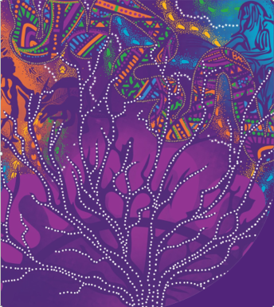Welcome to the Creating Brave Spaces for Health Communication module.
Acknowledgement of Country
 We would like to acknowledge the Traditional Custodians of the lands on which this module was designed and developed, the Yuggera and Turrbal people. We invite you to learn about and acknowledge the Traditional Custodians of the lands on which you join us.
We would like to acknowledge the Traditional Custodians of the lands on which this module was designed and developed, the Yuggera and Turrbal people. We invite you to learn about and acknowledge the Traditional Custodians of the lands on which you join us.
We would like to pay our respects to the Ancestors and Descendants of these lands and acknowledge their continued cultural and spiritual connections to Country. We would also like to recognise their valuable contributions to Australian and global society.
Acknowledging Country is not a tick box exercise, particularly in this module about creating brave and safer spaces in health communication. Acknowledging Country is a process for learning and respectfully engaging in cultural protocols from your own cultural position. By situating ourselves in relationship to Country, we are seeking to be open and to reflect on the space and place we occupy – working to make it more culturally respectful and inclusive. With that in mind, we would like to acknowledge the tremendous contribution of Aboriginal and Torres Strait Islander peoples to Western ideas and understanding of the concepts and practices that we will be learning about in this module.
Learning Objectives
 With these important introductory notes, let’s dive into the Learning Objectives for this module:
With these important introductory notes, let’s dive into the Learning Objectives for this module:
By the end of this module, you will be able to:
- Understand the concepts ‘identity’ and ‘culture’
- Identify and understand how identity and culture inform the differences between cultural competence, cultural safety and cultural humility in health communication
- Identify the role of reflection and reflexivity in creating brave and safer spaces for health communication 1,2
- Understand the importance of creating brave and safer spaces for health communication1,2
Disclaimer: Sometimes learning is a bit uncomfortable. You may be aware of these feelings during some parts of this module. We encourage you to notice when this is happening and spend time to reflect on why these feelings of discomfort might have arisen to deepen your learning experience.
As you go through this module, we suggest that you1:
- Understand that you may not agree with everything about this aspect of health communication
- Own your own intentions and impact in health communication
- Enter into health communication challenges by choice and with intention
- Consider what respect looks like for you as you engage with this module and as you seek to apply this to health communication contexts
- Remember to challenge ideas and not people.
5. The process of creating and engaging in brave and safer spaces in health communication
There is no one-size-fits all way to do this work. Rather, it is a non-linear process that needs to be negotiated case-by-case, held gently, and approached with a sense of experimentation and flexibility.
So, as a first step in your process, it is important for you and the people you are engaging in conversation with to develop ground rules together.
Some basic foundations include2,16:
- taking note of and naming existing power dynamics and working toward balancing them;
- cultivating humility and compassion;
- speaking and listening with respect (no interrupting or judging);
- speaking to or from our own lived experiences only; and
- honing the ability to regulate our emotions and thoughts when we are uncomfortable or in conflict.
The tips we offered at the beginning of this module also apply here1:
- Understand that you may not agree with everything;
- Own your own intentions and impact;
- Enter into challenges by choice and with intention;
- Consider what respect looks like for you; and
- Remember to challenge ideas and not people.
Reflexivity and cultural humility (i.e. delving deeply into our conditioned and inherited Ways of Knowing, Being, and Doing and working to unpack unconscious biases) are tools that allow us to become more aware of the ways we move in the world and perhaps hold our discomfort and difficulties with a little less rigidity. When we do this, we might find that it becomes more and more possible to engage and grow in brave and safer spaces, which have the potential to transform ourselves and our communities.
Let’s hear from a panel of health professionals about the work they have done and the lessons they have learned while working to create brave and safer spaces.
You can see how the concepts and tools we have unpacked in this module—identity, culture, cultural competence, cultural safety, cultural humility, and reflexivity—are key for developing our ability to engage in brave and safer spaces, to learn from mistakes and participate in more equitable and effective ways of engaging in health communication.
